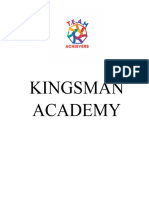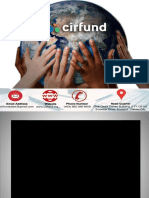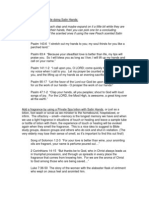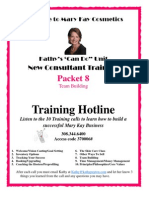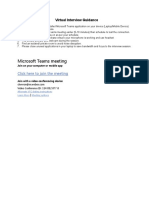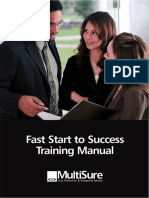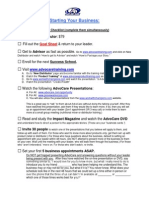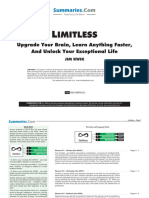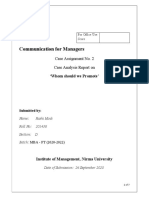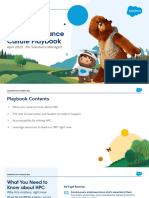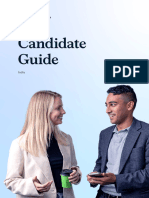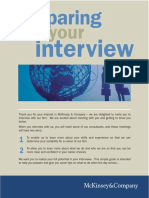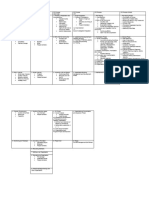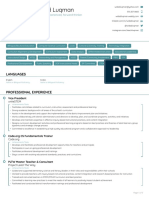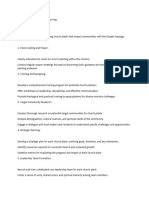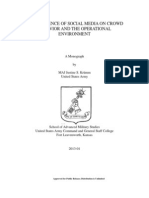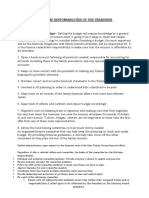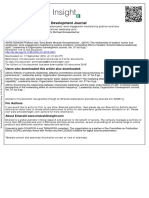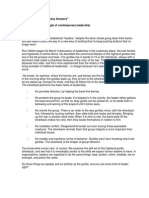Candidate
Guide
McKinsey Firm Functions
� Thank you for your interest
in joining McKinsey.
We want you to feel excited,
prepared, and informed
about our recruiting process.
But most of all, we want
you to succeed. Following is
information about the process
and tips for how to prepare.
Sincerely,
McKinsey Recruiting
2 Candidate Guide
� Contents
Get to know us better 4
Diversity matters 7
Interview process overview 8
How can I prepare? 10
Tips for your virtual interview 13
Benefits 15
Keep in touch 17
Appendix 18
3 Candidate Guide
� Get to know
us better
McKinsey is a global management consulting firm committed to helping
organizations accelerate sustainable and inclusive growth. We work with
clients across the private, public, and social sectors to solve complex
problems and create positive change for all their stakeholders. We combine
bold strategies and transformative technologies to help organizations
innovate more sustainably, achieve lasting gains in performance, and build
workforces that will thrive for this generation and the next.
Careers beyond consulting
In addition to consulting or client-facing roles, thousands of talented
colleagues around the world bring their skills, experience, and perspectives
to McKinsey’s internal and technology roles to make meaningful impact
and keep the firm operating at its best. With roles spanning 10 different
functions, a range of disciplines, and various career paths, our internal roles
are core to running our firm and present endless opportunities to make your
own McKinsey.
4 Candidate Guide
� 12K+ 10
colleagues functions, from visual
130+
cities with offices
in McKinsey’s internal graphics to finance in 65+ countries
roles globally to communications
Our firm is designed to operate as one—a single global partnership united
by a strong set of values, including a deep commitment to diversity,
and making positive social impact through our work and the way we run our
firm. Read more about all of our internal functions and career paths on the
internal roles website.
“Everyone I’ve met goes above and
beyond to help one another: ad hoc
questions, mentoring from senior
colleagues - anything necessary to
learn and develop. Working here
opened so many opportunities for me;
I’ve grown a lot.”
Olga
Prague,
Czech Republic
“After graduation, I chose McKinsey
based on its inclusive culture, incredible
benefits, and opportunities to grow.
I’ve found my work home at McKinsey,
and plan to be here for many years
to come.”
Preston
Tampa, USA
5 Candidate Guide
� ESG
2022 Environmental, Social, and Governance Report
Our ESG report, Creating a More Sustainable, Inclusive, and Growing
Future for All, showcases our measurable progress toward creating
positive, enduring change in the world. This compelling collection of stories
and statistics details the many ways colleagues at our firm are helping
to catalyze decarbonization, drive inclusive growth, and set the standard for
accountability and compliance.
“Our firm’s Purpose is to help
create positive, enduring
change in the world. We aspire
to do this by accelerating
sustainable and inclusive
growth through direct
and measurable impact in
partnership with our clients.”
Bob Sternfels
Global Managing Partner
6 Candidate Guide
� Diversity
matters
Diversity and inclusion aren’t departments, efforts, or projects. They’re how
we live, what we respect, and a fundamental aspect of our success.
Our global affinity groups support our people, providing a welcoming
environment where mentorship and community create a sense
of belonging and growth.
These networks include:
— McKinsey Black Network
— Veterans@McKinsey
— Access McKinsey
— McKinsey’s Hispanic and Latino Network
— Asians at McKinsey
— our LGBTQ+ network, GLAM
Learn more about our commitment to diversity and inclusion.
7 Candidate Guide
� Interview
process overview
Below is a typical interview process, but your exact experience will
differ depending on the role for which you apply. It may consist
of phone interviews, language assessment, problem-solving sessions,
and in-person or video interviews. Many interviews will be virtual now but
offer the same great experience no matter how far apart you are from
your interviewer. Your recruiter will communicate the steps and guide
you through the process so you know what to expect.
8 Candidate Guide
� 1 Application
2 Phone interview
Functional expertise Expected timeline
3 interview, role
simulation, and/
(from application to offer):
seven to 10 weeks
or skills assessment but may differ by role
4 Final stage interviews1
5 Employment contract
At every stage, our goal is to get to know you better and help you become
familiar with our culture, values, and work environment. You can always
ask questions and seek feedback—two important elements of our
McKinsey culture.
1
The final stage may consist of multiple one-on-one or panel interviews.
9 Candidate Guide
� How can I prepare?
Below are tips as you prepare for your interviews.
1
Carefully read the job description for which you have applied
Pay special attention to the “what you’ll do” section. Try to think about the
most important responsibilities of the position and prepare questions if you
find anything unclear.
2
Familiarize yourself with our firm, culture, and values
Our culture and values are important to us. We recommend you read
information about the firm and the function for which you are applying.
You can find useful information about our functions on our Careers site
and also learn about our values and mission.
10 Candidate Guide
� 3
Learn about the START technique
We are interested in learning about your professional experience
and motivation, so please be prepared to speak about your education, work
history, and interest in the role. You can reflect on areas such as teamwork
or the most significant successes and challenges you met. One useful way
to structure the story of your experience is to use the START technique when
answering interview questions. START is an acronym for situation, task,
actions, results, and takeaway.
S
Situation: Begin by describing the context of the situation
you’ve chosen: what was happening, how it happened,
and why.
T
Task: Continue by explaining your role in the situation.
Provide detail about what you were accountable for and what
objectives you were expected to achieve.
A
Actions: Describe your thought process and the steps you
took to come up with viable solutions. While we appreciate
your ability to work with teams, this should focus on your own
work and how you problem-solved independently.
R
Results: conclude talking about your experience with
the results you obtained after taking the actions. Speak
about what you achieved, whether the objectives were met,
and why.
T
Takeaway: Reflect on the experience, share learnings from
it, and tell how they’re applicable to the role for which you are
applying.
While answering questions, try to be specific and use
real-life examples.
11 Candidate Guide
� 4
Bring your questions
Interviewing is a two-way process—it helps us learn about you as a potential
colleague and helps you learn about McKinsey and what you could do here.
If you have any questions about the process, firm, or position, do not hesitate
to ask.
5
Prepare for the interview in English
We use English on a daily basis, therefore we want to assess your language
skills during the interview. Please remember to use business language.
6
Relax and be yourself
We want you to succeed and look forward to getting to know you.
“My advice for the interview process:
Show up to interviews as your authentic
self, take note of how you feel and think
through the role simulations, and ask
questions to make sure you align well
with McKinsey’s culture and values.”
Hanna
Phoenix, USA
“If I could offer interviewing advice,
it would be the following: Think of
all your achievements, successes, all
the things you’re good at, and all the
business challenges that made you
who you are.”
Adrianna
Poznań, Poland
12 Candidate Guide
� Tips for your
virtual interview
— Use a quiet, distraction-free room with a stable internet connection.
— Dress similarly to what you’d select for an interview at the office.
Our office dress code is business casual.
— When possible, sit with a window or light in front of you so the
interviewers can see you clearly. Aim to find a neutral background.
— Have anything you may need—such as a pen, your resume or water—
within arm’s reach.
— Don’t hesitate to ask for a question to be repeated, request a minute
to gather your thoughts, or say you need a short break. This is your
interview and we want you to feel comfortable to perform at your best.
— Check your tech (see appendix for more detail).
13 Candidate Guide
� “Fresh out of college, I was given the
opportunity to work with a global team,
and leadership entrusted me with great
responsibilities. This paved my path for
future roles. These are a few of many
reasons I look forward to starting my
day at work even after 12 years.”
Ajay
Chennai, India
Preparing for online assessments and interviews
Read our tips on how to prepare for skills assessment and any interview type
(see appendix for more detail).
Support to perform at your best
McKinsey recruits and hires talented people from a range of backgrounds.
If you need special arrangements or accommodations during the
assessment process due to reasons of health or disability, reach out to us
to help us better understand what adjustments would be helpful.
We want to give you the opportunity to perform at your best throughout
the selection process.
If you have any questions, your recruiter is
there to support you through the journey.
There are also many resources on
our website to further support your
preparation.
14
� Benefits
As a people-first firm, we offer a competitive salary, plus an exceptional
benefits package1 that includes:
1
Benefits vary by region and depend on your exact location. Temporary or part-time firm members will not be eligible
for some of these benefits. The benefit offerings are subject to change and may vary based on role or hiring terms.
Additionally, certain benefits and eligibility to receive them may be determined by a third party under the terms of
a group benefits plan.
15 Candidate Guide
� Personal health and well-being programs, including medical,
dental, mental health support, and vision coverage for you,
your spouse/domestic partner, and children
Wellbeing initiatives and connectivity events
Time away, including paid time off and additional paid time off
to volunteer and support charitable causes
Family support programs
Generous maternity and paternity leaves
Life and business travel accident insurance
Learning programs (including unlimited access to e-learning
courses), coaching/mentorship opportunities, and feedback
culture
Professional development opportunities for career growth
across the firm
International, diverse, equitable, and inclusive environment
with office- and firm-wide initiatives and communities
Flexible working models (depending on the role, function,
and individual)
Modern office spaces with well-stocked cafeterias/pantries
16 Candidate Guide
�Keep in touch
Part of our mission statement is to build a great firm that
attracts, develops, excites, and retains exceptional people.
As recruiters, we’re here for you every step of the way,
from the initial assessment to accepting a job offer.
We’ll guide you through the process, answer your
questions, and help you to get to know us better.
If there’s anything you would like to let us know or ask about prior to your
interview, please do not hesitate to contact us. In case you are no longer
available for the scheduled step of the recruiting process, please notify
us about it beforehand so that we can rearrange your assessment.
Website
Facebook
Instagram
LinkedIn
Blog
� Appendix
Below you’ll find information on what to expect during various types
of interviews and exercises that may be part of your recruiting process.
Language skills assessment
This assessment consists of three parts: 1) fluency, 2) vocabulary, and
3) spelling. The assessment will take approximately 10 minutes to complete.
After you have completed all tasks, a message will appear to confirm that you
have finished.
Technical interviews
A technical interview will focus on exploring the technical or functional skills
most relevant to the role. We are keen to understand the skills you currently
have, the level of expertise you’ve gained so far, and the experiences you’ve
had in applying those skills.
As preparation, reflect on the role-relevant skills you have, and prepare
to describe some examples when you have applied them. Be ready
to describe the issues, problems or choices you faced, the specific skills you
applied, and the outcome.
“Be your most authentic self. You have
something to offer McKinsey, and
you’re here for a reason. We want you
to find your happiness and success here.
Show us who you are because we want
you to bring your fullest self to work.”
Ranika
Tampa, USA
18 Candidate Guide
� Behavioral interviews
We will ask you to talk through some of your past experiences that will allow
you to demonstrate the behaviors we’re looking for in the role.
As preparation, take some time to reflect on some recent experiences you
can draw on. Examples from the last 3-5 years are usually best and, while
we’d expect some of these to come from previous work (unless this is your
first role), some can also come from other environments (e.g., education,
voluntary positions).
Behaviors we may well explore with you, among others, are personal impact,1
inclusive leadership,2 drive, and self-development. If your role involves
leading or managing others, we’ll discuss this as well.
We also recommend you consider where your greatest strengths lie
in relation to this role, and come prepared to talk through what really
motivates you about this opportunity.
“When interviewing at McKinsey, bring
your authentic self and be excited about
your interviews; it’s not only about us
getting to know you, but you finding
your fit here.”
Jan
Manila, Philippines
“I wasn’t sure of the exact path
I wanted to pursue after I graduated
from university. I chose McKinsey
knowing I would learn about a variety
of roles and have development
opportunities before selecting my
area of specialization.”
Michał
Poznań, Poland
1
Interacting effectively with people to create positive, enduring change.
2
Ability to lead people with different backgrounds and create belonging where everyone can be at their best.
19 Candidate Guide
� Problem-solving exercises
1. Problem-solving scenario (PSS)
A PSS will involve discussing a hypothetical situation with your interviewer.
We’ll provide you with background information and ask you to think about the
problem, its potential solutions, and/or actions you would take. We’ll ask you
some specific questions and may share more information as the conversation
progresses.
The PSS doesn’t require any specific preparation and is not designed
to explore your technical expertise. Instead, it provides an opportunity
to demonstrate how you approach ambiguous challenges, identify important
issues, deal with the implications of facts and data, formulate conclusions
and recommendations, and articulate your thoughts in a structured way.
2. Problem-solving discussions (PSD)
We will present you with two role-relevant hypothetical scenarios and will ask
you to talk through what you would do and why. We’ll ask specific questions,
may share more information as the conversation progresses, and will observe
how you think through the situation. Please come prepared to discuss
hypothetical scenarios in a structured way, breaking down the situation into
components and sharing solutions and/or actions you would take.
3. Problem-solving interview (PSI)
A PSI combines one hypothetical scenario (as PSD described above) and one
question exploring how you solved problems in the past. The scenario will be
general enough to suit any role rather than set in the specific context of the
role for which you have applied.
Please see the PSD section above for tips on how to prepare for the first
part. To prepare for the question on how you solved problems in the past, we
recommend you reflect on problems you faced that did not have an obvious
answer. This could be in various contexts: work, education, community, etc.
Please come prepared to talk through the problem, how you approached it,
and the outcome.
20 Candidate Guide
� “McKinsey is not only a place to work.
It’s a place to learn, grow, thrive,
and be your best self. McKinsey gives
space for you to break the mold and
innovate in any role.”
Francisco
San José, Costa Rica
“The biggest factors for me in choosing
to work here were the opportunities
for growth, commitment to diversity
and inclusion, and people I connected
with during the interview process.”
Yolanda
Phoenix, USA
Role simulations
A role simulation will involve demonstrating the technical, functional
or leadership skills most relevant to the role for which you have applied.
This may include a role-play or a task-based role simulation. We are
interested to see how you put your skills into practice.
As preparation, reflect on the role-relevant skills you have developed and
the types of situations you may need to apply them to in the role. Be ready
to respond to a presented scenario and then engage in a discussion on why
you completed the task or role-play the way you did.
21 Candidate Guide
� “I learned of McKinsey through a friend
and planned to stay for a year. Nearly
20 years later, I cannot think of leaving
because of the firm’s culture, people,
leaders, and opportunities to grow.”
Reena
Bengaluru, India
Check your tech
— Check your internet connection. Consider using a LAN cable, which may
provide a better connection than Wi-Fi.
— Make sure your device (computer, tablet, or phone, whichever you feel
most comfortable working with) is fully charged.
— Use your computer’s camera function to check the lighting in advance.
— When possible, use a headset rather than your device’s speakers.
This can improve sound quality and eliminate background noise.
— Ensure you have easy access to your email inbox;
this will be necessary during the technical exercise.
— Familiarize yourself with the video platform
using the test link provided in your email.
22 Candidate Guide
� Thank you for your
interest in McKinsey.
We look forward to
getting to know you!






